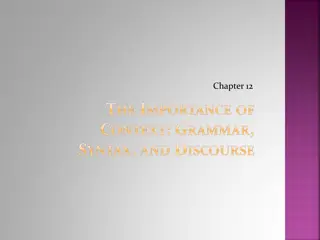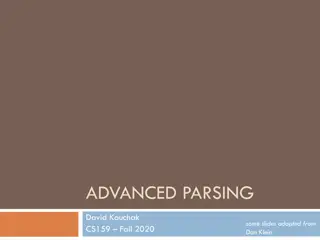Understanding Top-Down Parsing in Context-Free Syntax
Context-free syntax expressed with context-free grammar plays a key role in top-down parsing. This parsing method involves constructing parse trees from the root down to match an input string by selecting the right productions guided by the input. Recursive-descent parsing, Rule Sentential Forms, and examples like parsing x-2*y are outlined. The importance of making the right choice to avoid non-termination issues in parsing is highlighted, along with the risk of left-recursive grammars causing infinite loops in parsers.
- Top-Down Parsing
- Context-Free Grammar
- Recursive-Descent Parsing
- Parsing Techniques
- Grammar Ambiguity
Download Presentation

Please find below an Image/Link to download the presentation.
The content on the website is provided AS IS for your information and personal use only. It may not be sold, licensed, or shared on other websites without obtaining consent from the author. Download presentation by click this link. If you encounter any issues during the download, it is possible that the publisher has removed the file from their server.
E N D
Presentation Transcript
Parsing: Context-free syntax is expressed with a context-free grammar. The process of discovering a derivation for some sentence.
Recursive-Descent Parsing 1. Construct the root with the starting symbol of the grammar. 2. Repeat until the fringe of the parse tree matches the input string: Assuming a node labelled A, select a production with A on its left-hand-side and, for each symbol on its right-hand-side, construct the appropriate child. When a terminal symbol is added to the fringe and it doesn t match the fringe, backtrack. Find the next node to be expanded. The key is picking the right production in the first step: that choice should be guided by the input string.
Rule Sentential Form Input Example: Parse x-2*y Example: 1. Goal Expr 2. Expr Expr + Term 3. 4. 5. Term Term * Factor 6. | Term / Factor | Expr Term 7. | Factor | Term 8. Factor number 9. | id
Rule Sentential Form Goal Expr Expr + Term Term + Term Factor + Term id + Term id + Term Expr Expr Term Term Term Factor Term id Term id Term id Factor id num id num id Term id Term * Factor id Factor * Factor x | 2*y id num * Factor id num * Factor id num * id id num * id Input | x 2*y | x 2*y | x 2*y | x 2*y | x 2*y | x 2*y x | 2*y | x 2*y | x 2*y | x 2*y | x 2*y | x 2*y x | 2*y x | 2*y x | 2*y x 2 | *y x | 2*y x | 2*y - 1 2 4 7 9 Example: Parse x-2*y Example: 1. Goal Expr 2. Expr Expr + Term 3. 4. 5. Term Term * Factor 6. | Term / Factor | Expr Term 7. | Factor | Term 8. Factor number 9. Fail Back 3 4 7 9 Match 7 9 Fail Back 5 7 8 match 9 match | id x | 2*y x 2* | y x 2* | y x 2*y |
Example: Parse x-2*y Rule Sentential Form - Goal 1 Expr 2 Expr + Term 2 Expr + Term + Term 2 Expr + Term + Term + Term 2 Expr + Term + Term + + Term Input | x 2*y | x 2*y | x 2*y | x 2*y | x 2*y | x 2*y Example: 1. Goal Expr 2. Expr Expr + Term 3. 4. 5. Term Term * Factor 6. | Term / Factor | Expr Term 7. | Factor | Term 8. Factor number 9. | id Wrong choice leads to non-termination! This is a bad property for a parser! Parser must make the right choice!
Left-Recursive Grammars Definition: A grammar is left-recursive if it has a non-terminal symbol A, such that there is a derivation A Aa, for some string a. A left-recursive grammar can cause a recursive-descent parser to go into an infinite loop.
Eliminating left Eliminating left- -recursion recursion: In many cases, it is sufficient to replace A Aa | b with A bA' and A' aA' | Example: Sum Sum+number | number would become: Sum number Sum' Sum' +number Sum' |
Eliminating Left Recursion Example: 1. Goal Expr 2. Expr Expr + Term 3. 4. Applying the transformation to the Grammar of the Example we get: Expr Term Expr' Expr' +Term Expr' | Term Expr' | Term Factor Term' Term' *Factor Term' | / Factor Term' | (Goal Expr and Factor number | id remain unchanged) Non-intuitive, but it works! 5. Term Term * Factor 6. | Term / Factor | Expr Term 7. | Factor | Term 8. Factor number 9. | id
Where are we? We can produce a top-down parser, but: if it picks the wrong production rule it has to backtrack. Idea: look ahead in input and use context to pick correctly. How much lookahead is needed? In general, an arbitrarily large amount. Fortunately, most programming language constructs fall into subclasses of context-free grammars that can be parsed with limited lookahead.
Predictive Parsing Basic idea: For any production A a | b we would like to have a distinct way of choosing the correct production to expand. FIRST sets: For any symbol A, FIRST(A) is defined as the set of terminal symbols that appear as the first symbol of one or more strings derived from A. E.g. Expr Term Expr' Expr' +Term Expr' | Term Expr' | Term Factor Term' Term' *Factor Term' | / Factor Term' | (Goal Expr and Factor number | id FIRST(Expr' )={+,-, }, FIRST(Term' )={*,/, }, FIRST(Factor)={number, id}
The LL(1) property If A a and A b both appear in the grammar, we would like to have: FIRST(a) FIRST(b) = . This would allow the parser to make a correct choice with a lookahead of exactly one symbol!
Left Factoring What if my grammar does not have the LL(1) property? Sometimes, we can transform a grammar to have this property. Algorithm: 1. For each non-terminal A, find the longest prefix, say a, common to two or more of its alternatives 2. if a then replace all the A productions, A ab1|ab2|ab3|...|abn| , where is anything that does not begin with a, with A aZ | and Z b1|b2|b3|...|bn Repeat the above until no common prefixes remain Example: A ab1| ab2| ab3would become A aZ and Z b1|b2|b3 Note the graphical representation: b1 ab1 A aZ b2 A ab2 b3 ab3
Example Term | Factor Factor number | id Goal Expr Expr Term + Expr | Term Expr | Term We have a problem with the different rules for Expr as well as those for Term. In both cases, the first symbol of the right-hand side is the same (Term and Factor, respectively). E.g.: FIRST(Term)=FIRST(Term) FIRST(Term)={number, id}. FIRST(Factor)=FIRST(Factor) FIRST(Factor)={number, id}. Applying left factoring: Factor * Term | Factor / Term Expr Term Expr Expr + Expr | Expr | FIRST( ) FIRST(+) FIRST( )= = Term Factor Term FIRST(*)={*}; FIRST(/)={/}; FIRST( )={ }; Term * Term | / Term | FIRST(*) FIRST(/) FIRST( )= = FIRST(+)={+}; FIRST( )={ }; FIRST( )={ };
Example (cont.) Rule Sentential Form Input 1. Goal Expr 2. Expr Term Expr 3. Expr + Expr 4. | - Expr 5. | 6. Term Factor Term 7. Term * Term 8. | / Term 9. | 10. Factor number 11. | id The next symbol determines each choice correctly. No backtracking needed.
Example (cont.) Rule Sentential Form Goal Expr Term Expr Factor Term Expr id Term Expr Match id Term Expr 9 id Expr 4 id Expr Match id Expr 2 id Term Expr 6 id Factor Term Expr 10 id num Term Expr Match id num Term Expr 7 id num * Term Expr Match id num * Term Expr 6 id num * Factor Term Expr 11 id num * id Term Expr Match id num * id Term Expr 9 id num * id Expr 5 id num * id Input | x 2*y | x 2*y | x 2*y | x 2*y | x 2*y x | 2*y x | 2*y x | 2*y x | 2*y x | 2*y x | 2*y x | 2*y x 2 | *y x 2 | *y x 2* | y x 2* | y x 2* | y x 2*y | x 2*y | x 2*y | 1. Goal Expr 2. Expr Term Expr 3. Expr + Expr 4. | - Expr 5. | 6. Term Factor Term 7. Term * Term 8. | / Term 9. | 10. Factor number 11. | id - 1 2 6 11 The next symbol determines each choice correctly. No backtracking needed.
Conclusion Top-down parsing: recursive with backtracking (not often used in practice) recursive predictive Nonrecursive Predictive Parsing is possible too: maintain a stack explicitly rather than implicitly via recursion and determine the production to be applied using a table (Aho, pp.186-190). Given a Context Free Grammar that doesn t meet the LL(1) condition, it is undecidable whether or not an equivalent LL(1) grammar exists. Next time: Bottom-Up Parsing























